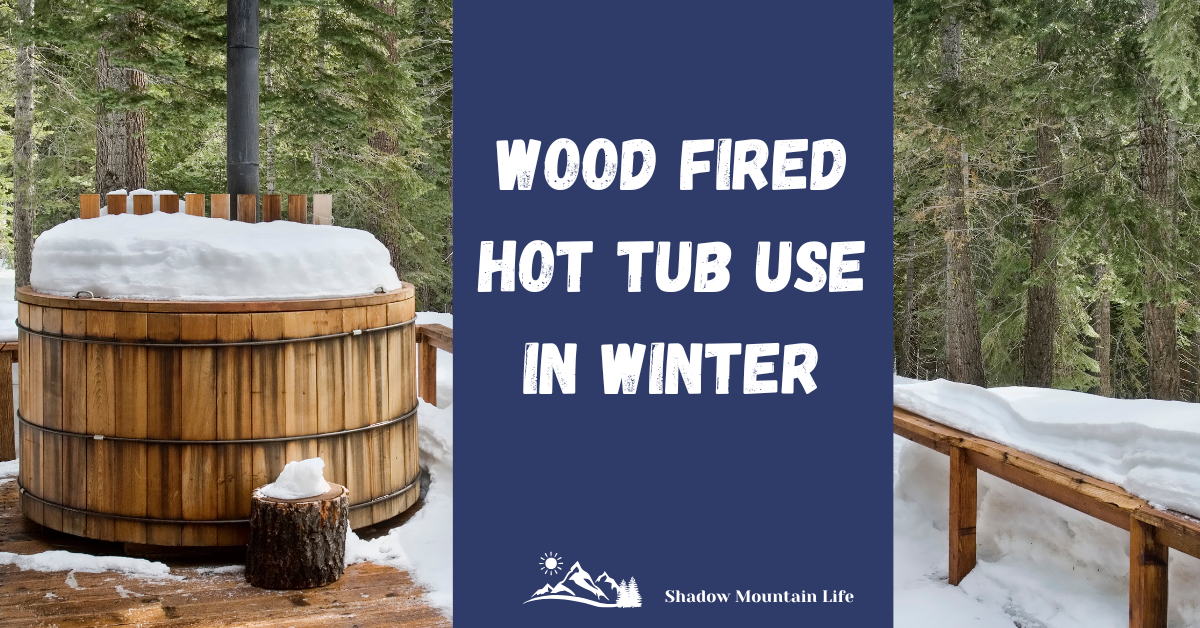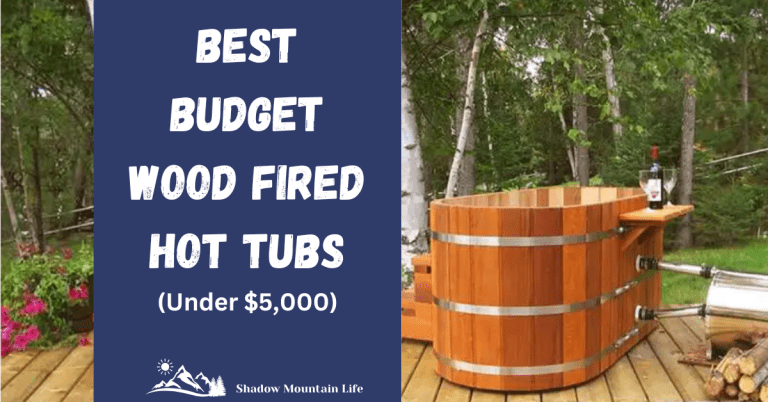Wood Fired Hot Tub Winter Use: Cold Weather Tips and Tricks for 2025
Picture this: a snowy winter evening, steam rising from your wood fired hot tub as you sink into its warm embrace. Bliss, right? But winter also presents unique challenges for hot tub owners. Tricky maintenance, and unpredictable temperatures can turn your relaxing soak into a frustrating ordeal.
Not to worry! In this guide, we’ll take a look at some tips and tricks to keep your wood fired hot tub running smoothly all winter long. From heat retention hacks to cold-weather care, we’ve got you covered.
New to wooden hot tubs and curious about how they work? Learn more: Complete Guide to Wood Fired Hot Tubs: From Installation to Maintenance
Medical Disclaimer: We are not doctors. The health information in the article is for informational and educational purposes only. Please consult your doctor or other healthcare professional when making medical decisions.
Affiliate Disclaimer: We may make a commission if you purchase something through our links. Thank you!

Preparing Your Wood-Fired Hot Tub for Winter
Getting a wood fired hot tub ready for winter does take some preparation if you don’t want to deal with frozen components and ice on top of the firebox. Think of good preparation as a prelude to cozy winter soaks.
First off, cleaning is everything. Before winter hits, give your hot tub a deep clean. Drain the water completely, scrub the inside with a gentle, non-toxic cleaner, and rinse it thoroughly. You don’t want to leave any residue that could freeze or gunk up your system.
Next, inspect for damage. Always check the tub itself, the pipes, and the firebox for any signs of wear and tear. Patch up anything questionable with a waterproof sealant and replace any worn-out components before the cold hits.
Placement also matters more than you’d think. If you can, position your hot tub somewhere sheltered from the harshest winds, like near a fence or under a pergola. Placing your tub closer to the house will help it stay warmer and give you a shorter walk on cold nights!
Finally, don’t skimp on insulation. Some tubs come with an insulated cover and be sure to use it if it does. You can also buy some rigid insulation and cut it to float on top of the water and another piece to go under the bottom of the hot tub. A well-insulated tub holds heat longer, which means you’ll use less wood to keep it warm—a win for your wood supply and your wallet!

Efficient Heating: Keeping the Fire Burning
Heating a wood-fired hot tub in the dead of winter can feel like a game of strategy. It’s more than just throwing some wood in the stove.
First things first, choose the right wood. Hardwoods like oak and maple burn hotter and longer than softwoods like pine. Sure, softwood catches fire quickly, but it burns out fast, leaving you scrambling to restock. Keeping a mix of softwood for quick fire starts and hardwoods for longer burns in a convenient location will prevent you having to trek back and forth to the log pile during your hot tub session.
The next trick? Proper stacking. Don’t just shove logs into the firebox and hope for the best. A crisscross pattern allows air to flow and keeps the fire roaring. Also, make sure your wood is dry. Wet or green wood doesn’t just make it harder to maintain heat—it also creates a smoky mess that can ruin the whole experience.
Once the fire’s going, monitor it closely to make sure it’s burning evenly. A metal poker is your best friend here for moving logs around and clearing ash. Speaking of ash, don’t let it build up. Too much ash can choke the fire, making it harder to keep the water at the perfect temperature, so be sure to clean out after every use.
Efficient heating is all about balance—choosing the right wood, tending the fire consistently, and letting it breathe. Master that, and you’ll enjoy your hot, steamy bath without the frustration of a constantly fading fire. It’s a skill worth perfecting!
Preventing Freezing in Cold Weather
While there are fewer installation and maintenance problems with wood fired hot tubs as compared to electric hot tubs, there are still some issues to consider.
Insulation is your best friend. Start with a basic thermal cover, but depending on your climate you may want to also wrap the exterior of the tub and pipes with foam insulation and heavy-duty thermal blankets. It might not look Pinterest-perfect, but it works! Pool noodles around exposed pipes are a cheap and effective insulation for pipes as well.
NOTE: You won’t have many exposed pipes with a submerged wood fire hot tub, however there are some extra issues to consider as this article from Timberline Wood Water Stoves describes. If you have an external heater type of wood burning hot tub, then you may need to have some extra insulation near the transfer pipes from the firebox to the tub.
Not sure about the differences between to two? Check out our post Wood Fired Hot Tub Heaters: Internal vs. External.
Another biggie? Don’t let the water sit stagnant. Moving water is much less likely to freeze. If you’re not using the tub daily, give the water a quick stir or consider a small submersible pump to keep it circulating.
If your tub is fully wood inside, you will want to drain it after each use as otherwise the water freezing can expand and cause cracks. If you have an aluminum or fiberglass tub interior, then you may be able to leave water inside depending on the temperature as long as the stove is drained and isolated by plugs from the water in the tub.
An electric stock tank or pond deicer can be used to prevent the water from freezing. This is a cheap way to keep your water from freezing and having to drain and refill the water every use. If you are using the tub every day, it may make sense to just keep feeding the fire and keeping the water warm that way.
Finally, keep a close eye on the weather. If a deep freeze is on the way and you’re not planning to use the tub, draining it completely is the safest bet. Frozen water expands, and even a little bit left behind can cause problems.

Enjoying Your Hot Tub Safely in Winter
Soaking in a hot tub while snow falls around you is pure magic, but winter brings its own set of safety concerns. From slippery stairs to icy decks, safety must be a priority.
Start with your surroundings. Ice is a real hazard, especially around the tub. It’s wise to keep a bucket of sand or salt nearby to sprinkle on walkways and steps. Anti-slip mats are a great addition too! Also, make sure the path to your hot tub is well-lit, especially if you’re soaking at night.
When it comes to the water itself, water temperature matters. While it’s tempting to crank it up, keep it between 100°F and 104°F. Anything hotter can lead to overheating, especially in colder weather when it’s harder to notice the signs. Taking a quick break if you start feeling lightheaded or too warm is always a good practice as well.
Hydration is key, even in winter. Hot water can dehydrate you faster than you’d expect. It’s easy to forget to drink enough when it’s cold, but staying hydrated keeps you safe and feeling good, so keep some water nearby.
With a few precautions, winter hot tubbing can be safe, cozy, and downright magical. So, light the fire, grab your towel, and soak with confidence!
Maintenance Tips for Winter Longevity
Keeping your wood fired hot tub in tip-top shape during winter takes some effort, but it’s worth it to avoid costly repairs and ensure you can enjoy it all season long. A little regular maintenance can go a long way, and after you make a routine of it, it will not be a big deal.
Start with weekly check-ins. Every week, take a few minutes to inspect the tub and its components. This includes checking for leaks, cracks, or frost buildup. Pay special attention to the firebox—ash can pile up quickly in winter when you’re using it more often. Clearing out the ash not only keeps your tub efficient but also prevents moisture buildup that can lead to rust.
Most wood fire hot tubs are made of cedar which is an excellent choice of wood due to its rot and mold resistant properties and doesn’t require a tremendous amount of maintenance.
Keep the water balanced. Even in winter, it’s important to check the water’s pH and alkalinity. If the levels are off, it can damage the tub’s interior and make the water unpleasant for soaking.
Protect the tub from snow and ice. A sturdy, insulated cover is a must, but don’t just set it and forget it. After heavy snowfall, be sure to clear the snow off the cover to prevent it from sagging or cracking. For added protection use a tarp over the cover during extreme weather—it’s a bit of extra work, but it keeps the tub in great condition.
Watch for heat loss. If you notice the water taking longer to heat up or struggling to maintain temperature, it’s time to check your insulation. Wrap exposed pipes and consider adding extra insulation to the tub’s exterior. A small investment here can save you wood and frustration in the long run.
Finally, stay on top of small repairs. If you notice a crack, a leak, or anything else out of the ordinary, fix it right away. Winter weather can make minor issues worse if left unchecked.

Extending the Season: Transitioning from Winter to Spring
As winter fades and the first signs of spring start to appear, your wood fired hot tub can still be a favorite spot for relaxation. But transitioning your tub from winter to spring requires a bit of TLC to keep it in top shape and ready for those breezy, cool spring evenings.
First, give it a thorough cleaning. Once the risk of hard freezes has passed, drain the tub completely and scrub it down. After a winter of heavy use, there’s often a buildup of debris and residue, especially if the tub’s been exposed to snow or wind-blown dirt. A mild, biodegradable cleaner to get the job done without harming the environment.
Next, check for wear and tear. Winter can be hard on both the wood and the metal components of the tub. Inspect the firebox, pipes, and any seals for cracks, rust, or other damage.
With warmer days ahead, adjust your heating routine. Spring evenings might still be chilly, but you won’t need as much wood to keep the water warm.
Finally, consider springtime accessories. Adding outdoor string lights or sprucing up the area with fresh plants can make the space feel refreshed and inviting. After all, your hot tub isn’t just functional—it’s a retreat!
By transitioning thoughtfully, you can extend the season and enjoy your wood-fired hot tub as the days grow longer and the air gets warmer. It’s the perfect way to soak in spring!
Winter doesn’t have to put a damper on your wood-fired hot tub experience. With the right preparation, maintenance, and a few clever tricks, you can enjoy relaxing soaks all season long. So, light up that fire, sink into the warmth, and let the cold weather melt away!







